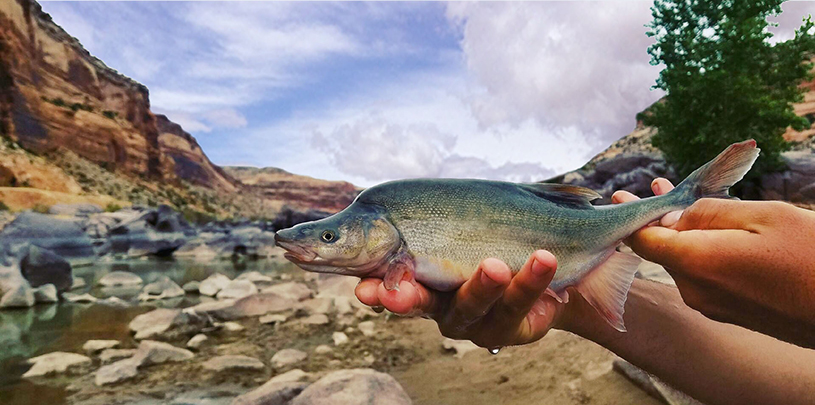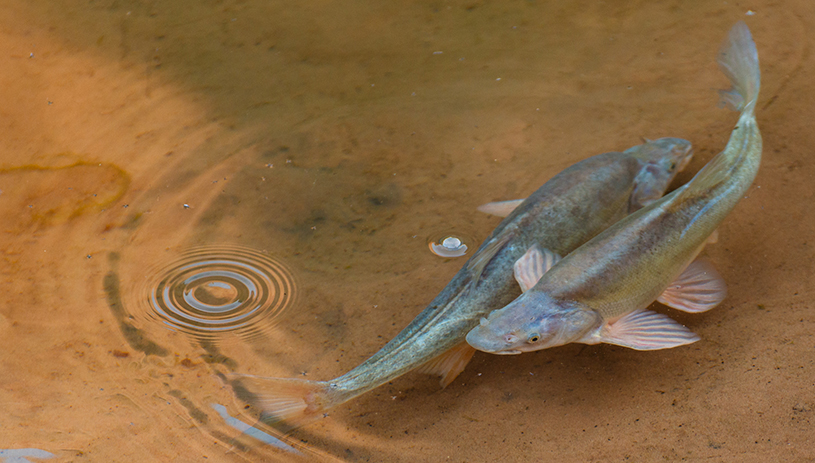
 by Lisa Winters, Communications Manager
by Lisa Winters, Communications Manager
Before the Colorado River flows through the Grand Canyon, it travels hundreds of miles down snowy mountain slopes, across sweeping plateaus, and through winding slot canyons. The Green River, the San Juan River, and many smaller ribbons of water flow down off the mountains to join the Colorado River, gathering together on their way to Lake Powell.
Collectively, this network of waterways is known as the upper Colorado River Basin, stretching across parts of Utah, Wyoming, Colorado, and New Mexico.
Typically, rivers get larger as you follow them downstream; their drainage area increases and more water flows between their banks. But not the Colorado River. Today, the biggest floods on the river tumble through Cataract Canyon, in the upper basin; by the time the overallocated river reaches Mexico, most of the water has been siphoned away.
What about the endemic fish — species found in the Colorado River Basin and nowhere else on Earth — that rely on these waters? Uniquely adapted to warm, muddy waters, these rare fish are running out of river.
Here are four finned friends of the upper Colorado River Basin:
 Logan Johnson holds a Colorado pikeminnow caught on the Green River in Whirlpool Canyon. BEN KIEFER, UTAH DIVISION OF WILDLIFE RESOURCES
Logan Johnson holds a Colorado pikeminnow caught on the Green River in Whirlpool Canyon. BEN KIEFER, UTAH DIVISION OF WILDLIFE RESOURCES
Growing up to six feet long and weighing over 80 pounds, the Colorado pikeminnow is the largest minnow native to North America. It is a top predator, eating other fish up to half its size, despite lacking teeth.
The torpedo-shaped, silvery minnow calls large, warm-water rivers of the Colorado River Basin home. Historically, Colorado pikeminnows were known to migrate hundreds of miles from Wyoming and Colorado to Mexico, but dams and human water use have restricted their habitat.
Today, the Colorado pikeminnow is federally endangered and only a few hundred fish are found in the upper reaches of the Colorado, Green, and San Juan rivers.
 A razorback sucker raised at the Ouray National Fish Hatchery in northern Utah. ROB MANSHEIM, U.S. FISH AND WILDLIFE SERVICE
A razorback sucker raised at the Ouray National Fish Hatchery in northern Utah. ROB MANSHEIM, U.S. FISH AND WILDLIFE SERVICE
True to its name, the razorback sucker can be identified by a unique bony ridge behind its head that looks like a boat keel. This olive and yellow-colored sucker hangs out near the river bottom, using its downward-facing mouth to scrape up insects and plant matter to eat.
Like the Colorado pikeminnow, razorback sucker also rely on the warm, muddy waters of large rivers in the Colorado River Basin, especially flooded backwaters and calm flat waters. However, dams have put a stop to big floods from snowmelt or monsoon storms, and block access to hundreds of miles of habitat. Nonnative fish, like northern pike or smallmouth bass, thrive in these more stable conditions, eating little razorback suckers and competing with the adults for food. Endangered razorback sucker raised in captivity are placed in the Green and Yampa rivers in northeast Utah and Colorado as well as the lower Colorado River, but they don’t survive for long after stocking.
 Bonytail chub. MICHAEL COLLIER
Bonytail chub. MICHAEL COLLIER
The rarest of these desert-dwellers, the silver-and-white bonytail chub, has a streamlined body with a very narrow, forked tail. The bonytail is a powerful swimmer, navigating with ease through fast-moving waters, and can live up to 50 years.
The endangered bonytail chub was common throughout the Colorado River Basin, from Mexico to Wyoming, before being almost completely wiped out. Now, tens of thousands of fish are raised in hatcheries before being stocked back into the Colorado River Basin, including the Green, White, and Yampa rivers in the upper basin. Few survive and consistent river flows, cold water temperatures, ravenous nonnative fish, and dams remain a significant threat to the bonytail chub.
 Humpback chub. JACK DYKINGA
Humpback chub. JACK DYKINGA
The humpback chub has, you guessed it, a prominent hump on its upper back. This “hunchback” is thought to help the fish navigate swift whitewater in the deep canyons of the Colorado River Basin and also probably helps the chub escape predators, since it’s too big to fit in their mouths. Similar to the bonytail, the humpback chub has a silvery, torpedo-shaped body, pointy nose, and forked tail.
Recently downlisted from endangered to threatened, today humpback chub find refuge at the confluence of the Little Colorado River and the Colorado River in the Grand Canyon, and north of the White River in northeast Utah.
What do all of these imperiled fish have in common? Over the span of millions of years, the Colorado pikeminnow, razorback sucker, bonytail chub, and humpback chub have adapted to the harsh conditions of the rivers of the desert Southwest, thriving in the churning floodwaters of springtime and in warm, muddy waters later in the year.
Unfortunately, increasing human demands and persistent drought threaten these already scarce water supplies and put these rare fish even further at risk. Keeping water in the river gives these fish a swimming chance.
Sign the petition. Drought is stressing groundwater and the Colorado River, which provides water to 40 million people and 5.5 million acres of agriculture across 30 tribal nations, seven U.S. states, and Mexico. Speak up for the Colorado River.
The Colorado River below Glen Canyon Dam is heating up. Find out why.
Read MoreGroundwater pumping at a uranium mine near the Grand Canyon will affect the canyon's springs, scientists says.
Read MoreHow does Colorado River water get divvied out to Colorado, Utah, Arizona, New Mexico, Nevada, California, Wyoming, Native American tribes, and Mexico?
Read More